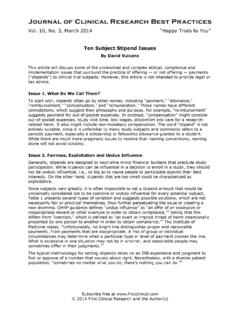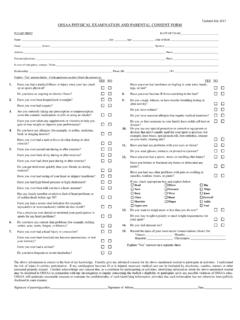Transcription of Vol. 5, No. 11, November 2009 “Can You Handle the …
1 Vol. 5, No. 11, November 2009 Can You Handle the Truth? Subscribe free at 2009 First Clinical Research and the Author(s) Questions in Site Selection Questionnaires By Norman M. Goldfarb Study sponsors and contract research organizations (CROs) distribute site selection questionnaires to collect information for evaluating whether to invite sites to participate in a study. Current questionnaires and the processes surrounding them are clearly inadequate, since most sites underperform their contracted commitments, which are often scaled back from questionnaire ,2 Sponsors share responsibility for this underperformance because they design and conduct the site selection process.
2 Site questionnaires can also: Determine the site s level of interest in the study. Interest the site in the study. Obtain statements and commitments to which the site can be held. Impress the site with the sponsor, perhaps for future studies. Collect information useful in changing or managing the study. Collect information for future studies. Help the site think through operational aspects of the study, such as subject recruiting. Help the site determine whether it wants to participate in the study. We cannot expect too much from site questionnaires.
3 They are an efficient way to collect certain types of information for screening purposes and as the basis for a discussion, but they cannot replace the discussion. They are no substitute for the human-to-human interaction and meeting of the minds that are essential to productive working relationships. In theory, a site qualification visit enables these interactions, but the common box-checking exercise is just a slow and inaccurate way to complete questionnaires. The site questionnaire thus needs to be designed as part of a larger process.
4 A thorough site selection process is time-consuming, but the adages look before you leap and measure twice, cut once clearly apply to site selection. Just because a question can be in a questionnaire does not mean it should be; asking the question in an interactive discussion may reveal essential subtleties and create person-to-person connections. For example, the site may offer a war story as its answer. War stories have little statistical value, but they communicate human values that are difficult to share in other ways. The last two purposes above are critical.
5 Sponsors can never have complete, up-to-date information about a site. A properly designed questionnaire facilitates the site s decision process. If the site thinks through the study and realizes it is not a good fit, everyone saves time. Empowering the site helps build the relationship and may also elicit more honest answers. Sites need adequate information to answer questionnaires accurately. An obvious example is asking a site how many subjects it can enroll in a flu vaccination study without specifying the time parameters. The sponsor may not know essential information when distributing the questionnaires, but specificity is more likely to yield results that are comparable from site to site.
6 Subscribe free at 2009 First Clinical Research and the Author(s) 2 Site questionnaires should be designed to accomplish the sponsor s objectives. In particular, the questions should: Be necessary to the purpose. Be sufficient to the purpose. Be clear and unambiguous. Be straightforward to answer with readily available information. Provide adequate options and space for the answer. Allow a broad range of answers. Not reveal the right answer. Accommodate the characteristics of different types of sites. Show respect for the site.
7 Generate answers that the sponsor can interpret and score. Generate answers that the sponsor can validate for predictive ability. A well-designed questionnaire gives insights into the site s complex, subtle personality. True/false, multiple-choice and numeric answers are easy to read and tabulate, but they do not reveal the site s thought processes. Most sites can figure out the right answer. Elicit comments and allow space to elaborate on an overly simplistic answer. For example, the questionnaire may ask, How many subjects will come from inside your practice?
8 The answer is highly dependent on the site s organization: Is the investigator a sole-practitioner? If he or she is in a multi-physician clinic, how are treatment responsibilities shared? Do other departments in a hospital count? Sloppy questionnaires with typos, ambiguous questions, and inadequate space for answers tell sites that the sponsor is not very interested in the answers and does not respect the sites. Asking the same question in two different ways shows disregard for the site s time or disrespect for its competence. Sponsors should test all questionnaires on a sample of sites, or at least on internal personnel with site experience, before sending them to the entire site pool.
9 How many questions are sites willing to answer? The number of questions is only one factor in the site s assessment of the cost and benefit of completing a questionnaire. The primary costs are time, effort and aggravation. The benefits derive from the probability of being selected for a study that the site wants to conduct and the use the sponsor will make of the answers. A well-crafted questionnaire addresses both sides of the equation in numerous ways. The globalization of clinical research introduces even more variety into the suitability of questions and comparability of answers.
10 For example, there is no need for a sponsor to ask a Brazilian site if translation of the informed consent form is required. Many answers can be scored automatically or by low-cost labor with clear instructions. Scoring may vary by study. For example, satellite sites may be desirable in some studies, but taboo in others. A precise score for each answer is not important. Use broad ranges to triage sites into essential, possible and unlikely categories for appropriate follow-up. The scores can also be used to identify potential trouble spots at individual sites and for the site population as a whole.



